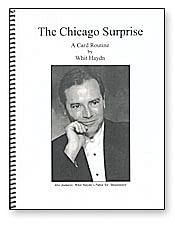The Chicago Surprise by Whit Haydn
Reviewed by Jamy Ian Swiss (originally published in Genii November, 2001)

"The Chicago Surprise" is one of Whit Haydn's pet routines, which he typically uses as an opener, based upon the neo-classic routine, "Red Hot Mama," also known as "Chicago Opener" possibly created by Al Leech, and popularized by Chicago bar performers Jim Ryan and Frank Everhart. Mr. Haydn's routine, combining the trick (depending on the outcome) with Eddie Fechter's wonderful "I've Got A Surprise For You," is excellent, and I recall seeing him perform it for me many years ago when we first met. But what is truly marvelous about this booklet is that while it is focused around a single card trick, the book is 35 pages, and I don't consider an inch of the text to be filler. The detailed description and theoretical analyses will not only allow you to master this trick and extract all of its entertainment and mystery potential, but present much broader concepts that may serve to inform all of your close-up work in the future.
Mr. Haydn's theories are somewhat off the mainstream in some areas, but I must say that I heartily agree with much of what he has to say, albeit not all. Agreement or not, however, Mr. Haydn presents his ideas with clarity and bold argument, and makes a compelling case, no matter how new some of these ideas will be to you (and many of them will be new, I promise you). Mr. Haydn takes an uncompromising approach to the impact that he wishes to achieve with his magic, and the precise mental state he hopes to induce in his spectators. This aspect of his approach I enthusiastically endorse. The author argues—as has Jim Steinmeyer and Teller, among others—that there is no "suspension of disbelief" in magic, bur rather that we wish to cut off that line of mental escape, rather placing the spectator "on the horns of a dilemma," namely that "There is no such thing as magic; There is no other explanation." This is a challenging and perhaps even aggressive stance, but I agree that it is the goal of effective magic. In order to achieve it, Mr. Haydn speaks of "constructing an argument" and eventually, with sufficient persuasion, achieving the spectator's mental "agreement" with that argument, until they are eventually trapped in a "logical conundrum. The result of this is a peculiar mental excitation—a burr under the saddle of the mind. If the operation is performed correctly, the patient will not be able to ignore the problem, but will keep coming back to it again and again."
Amen, brother.
Elsewhere Mr. Haydn folds into these positions what I would consider certain biases that need not in fact be integral to such goals. He displays a distinct dislike of story presentations, indeed almost any elaborate presentation that goes beyond essentially straightforward narrative scripting accompanied by situational humor. He insists that we do not use theater in magic in order to "add meaning." He states that "theater and story almost always trump magic." While I disagree with the generality of such declarative statements, and think that in some ways they reflect an unnecessarily limited view of magic, I do agree when he adds that "That does not mean that story can never work with magic. Just that it is difficult and requires the hand of an experienced artist." Fair enough. This reminds me of Darwin Ortiz's statement in Strong Magic that one should never do tricks in which the cards are personified. Were he to have offered that, "Tricks in which the cards are personified often suck," one could hardly argue. But one must be careful of flat statements, less one be stuck trying to extract one's foot from one's mouth. Consider the "Coterie of Queens."
Be that as it may, I certainly agree, and have in fact written almost identically, when Mr. Haydn suggests that if the performer "does not fool the audience at some point and create the experience of magic, he is not a magician. He may be an entertainer, he may be an artist, but he is not a magician." Finally, the author, after discussing the use of "Patter as Misdirection," provides as a bonus his presentation for the "Brainwave Deck." You might just put it to instantaneous use. This entire manuscript is a marvelous piece of work, and if it does not cause you much thought about magic, then something is terribly wrong.
